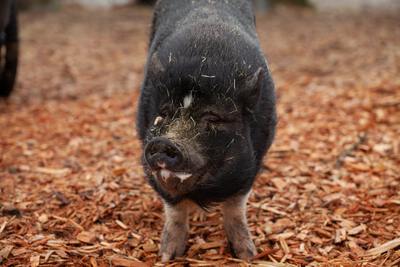
Compassionate Threads for Everyone!
What is vegan fashion? Vegan fashion is clothing and accessories made from cruelty-free sources, i.e. NO animal products were used in making the garments and gear, and no animal was harmed.
Why choose vegan fashion? Because animals are sentient beings with feelings - just like human animals have feelings. They, too, have the right to live out their lives freely.
Who are vegan fashionistas? Everyone who conscientiously chooses cruelty-free apparel are vegan fashionistas!
Famous personalities who choose vegan fashion include actress Pamela Anderson and Alicia Silverstone, actor Joaquin Phoenix, supermodel Christy Turlington, and popstar Pink, to name a few... And YOU, too, can become a vegan fashionista by reading the labels and buying wisely. Below are some common animal products found in clothes and accessories to watch out for.
Leather
Cattle hides, the skin of the animals, are not merely slaughterhouse byproducts but are valuable meat industry commodities. Downed cattle, animals who are too weak or sick to stand, are usually considered unfit for human consumption. They are left to die without food, water, or care until finally they are killed for their hides. Calves, lambs, and other young animals are often purposely slaughtered for "higher quality" leather products. Pigs, horses, and exotic animals like alligators, kangaroos, seals, elephants, and zebras are killed for their skins. The production of leather requires a range of noxious compounds and creates highly toxic chemicals.
The Leather Alternatives
Instead of buying leather clothing and leather accessories such belts, shoes, and purses - Look for products made with natural or man-made fiber like cotton, hemp, linen, microfiber, ramie, pleather, and imitation leather.
Wool - Angora
Cramped in wire cages for their entire lives, angora rabbits are often forced to endure extreme loneliness as well as bone deformities and other painful ailments caused by severe confinement. The rabbits are often forcibly restrained while their wool is clipped and shaved. They are often injured and traumatized in the process. Because female rabbits produce far more fur than male rabbits, the females are keep alive while the male ones are typically slaughtered at birth.
Wool - Cashmere
Shorn much earlier than their natural shedding time, cashmere goats often suffer from exposure to the cold and become more susceptible to illness. Typically, the goats are raised in filthy, crowded conditions, ear notched, dehorned, and castrated without anesthesia. They are sold for meat after their first fiber harvest.
Wool - Mohair
Although commercial goat meat and goat milk product is on the rise, the majority of goats are still used for mohair, the fabric or yarn manufactured from their fleece. Intolerably sensitive to cold temperatures and parasites, the goats often suffer miserably when their protective fleece is removed from their bodies. Like other animals used for fiber, these goats are commonly sold for slaughter when they are no longer considered profitable.
Wool - Sheep
Sheep are bred to produce excessive wool. During shearing, the majority of them are handled roughly. Their fleece is removed as quickly as possible, resulting in frequent injury. After only a few weeks of life, lambs typically endure painful mutilations without anesthesia, like tail-docking and castration. And many farmers still practice "mulesing," cutting off 4-by-6-inch folds of wrinkled skin around the animals' backsides. Also done without anesthesia, mulesing is ostensibly utilized to inhibit parasite infestation, although there are more effective and humane ways to prevent such problems. When the sheep are no longer producing prime wool, they are commonly transported to slaughterhouses in overcrowded trucks. Some are loaded onto massive live transport ships and are sent to slaughterhouses overseas. Many sheep become "downers" and are left to suffer and die slowly from neglect. Compressed wool, more commonly known as felt, is also produced through such practices.
The Wool Alternatives
Instead of buying heavy, wool socks and mittens, or expensive angora or cashmere sweaters, choose garments made with more light-weight and colorfast materials, like nylon, acrylic, polyester fleece, cotton, orlon, or synthetic shearling.
Fur
Minks, foxes, rabbits, lynxes, chinchillas, and even hamsters used in the fur industry are also raised on factory farms in small wire cages where the animals lack clean water and proper nutrition, and suffer from stress, fear, illness, and insanity. Resorting to extreme forms of slaughter in order to keep the pelts intact, fur farmers will often gas, poison, or electrocute the animals.
Wild animals trapping is another cruel technique utilized by the industry. The trapping process also kills many non-targeted animals, including dogs, cats, and endangered species of animals. The fur industry exploits also exploits wild animals such as beavers, raccoons, wolves, coyotes, and otters. These animals endure excruciating pain and intense fear when they are caught in inhumane steel-jaw leghold traps, body crushing traps, and strangling snares. In desperate attempts to escape, the animals sometimes gnaw at their own limbs to free themselves from the agony. Some trappers set up and abandon these cruel devices for days, only to return to bludgeon or shoot the dehydrated, famished, and petrified animals they have captured.
The Fur Alternatives
Faux fur - made of acrylic, mod-acrylic, or polyester fibers - is easy to find at most department stores and clothing shops.
Down
Down, the very soft feathers from the breasts of ducks and geese, is plucked from slaughtered birds or from forcibly restrained live ones. Those who undergo live defeathering may be plucked three to five times during their life. No matter how they are removed, feathers normally come from birds who endure a tortuous existence of confinement inside large warehouses. Whether utilized for feathers or raised for meat or foie gras (the diseased fatty liver of force-fed birds), ducks and geese are sent to slaughter after living out only a fraction of their natural lifespan. Down feathers, intended to keep birds and their eggs warm, are commonly found in pillows, jackets, and comforters for which it may take the feathers of dozens and dozens of animals to fill.
The Down Alternatives
Instead of paying high prices for down coats, vests, and comforters seek out products made from hypo-allergenic synthetic down, down alternative, polyester fill, or high-tech fabrics like Primaloft or Polarguard.
Silk
Silk comes from the caterpillars of the silk moth who protect themselves by spinning silk strands to form a cocoon. Each worm may produce up to 1.5 miles of continuous thread. To retain an unbroken thread of silk, farmers commonly boil, bake, or steam the cocoons, a process which kills the live being inside.
The Silk Alternatives
There are many common fibers available on the market that simulates the look and feel of silk, including nylon, rayon, polyester, Tencel, milkweed seepod fibers, and silk-cotton tree filaments.




